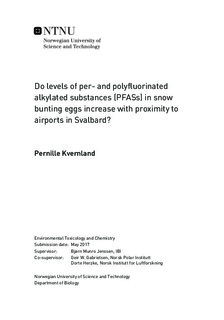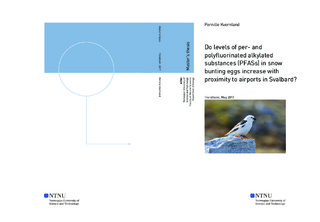| dc.description.abstract | Per- and polyfluorinated alkylated substances (PFASs) are used in a variety of industrial and consumer applications, including polymer materials and in aqueous fire fighting foam (AFFFs). Research over the last 20 years has shown that these compounds are ubiquitous environmental contaminants, extremely persistent, show toxic effects and accumulate in the food web.
Pollution research in the Arctic has traditionally focused on long range transport (LRT), but local pollution from historical and present day human activities also constitute important pollution sources in the Arctic. The overall aim of the present study was to examine if the use of PFASs in AFFFs at Longyearbyen and Ny-Ålesund airport may constitute a local source of contamination and contribute to the bioaccumulation of PFASs in terrestrial biota in Svalbard. Thus, eggs of snow buntings (Plectrophenax nivalis) were collected along a transect from Longyearbyen airport towards Adventdalen and around the airport in Ny-Ålesund in 2016.
A total of 11 perfluorinated carboxylic acids (PFCAs), 9 perfluorinated sulfonic acids (PFSAs) and 2 fluorotelomer sulfonates (FTSs) were detected in the egg content from snow buntings. Sum22 PFAS concentrations increased significantly from Adventdalen towards Longyearbyen and Longyearbyen airport. Sum22 PFAS concentrations in Ny-Ålesund were within the same range as Longyearbyen. Overall perfluorooctane sulfonate (PFOS) comprised the majority of the contamination burden and was found at highest concentrations at all four locations. PFCAs and PFSAs with carbon chain lengths of five or less were not detected.
Linear PFOS (linPFOS) constituted 78-96.5% of total PFOS in snow bunting eggs. The linPFOS comprised 78.7% and 78.4% at Longyearbyen airport and Longyearbyen, respectively, which were within range of the PFOS electrochemical fluorination (ECF) production standard for AFFFs (76-79% linPFOS) and indicative of a local point source. Adventdalen (89.9%) and Ny-Ålesund (96.5%) had a higher linPFOS percentage indicative of LRT or exposure to old legacy PFAS sources.
The levels of PFASs in snow buntings at Longyearbyen airport were 12-90 times higher compared to the other locations. The PFAS levels at this location were above toxicity threshold described in the literature for possible sensitive bird species and are therefore of toxicological concern. Future studies should elucidate whether or not the snow bunting is a sensitive species with respect to adverse effects of PFASs.
The present study show that the eggs from snow buntings living in the proximity of Longyearbyen airport are contaminated with PFAS, indicating the fire fighting training facilities at Longyearbyen airport as a point source of PFASs for the local biota that contribute to the bioaccumulation of PFASs in snow buntings residing here.
Ny-Ålesund differed from the other locations with respect to the PFSA:PFCA profile and the linPFOS:brPFOS profile, indicating a different source of exposure compared to the other locations. Further investigation for possible sources in the Ny-Ålesund area is therefore recommended. | |

